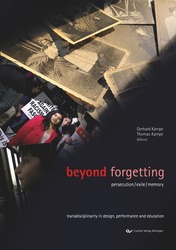| Fachbereiche | |
|---|---|
| Buchreihen (96) |
1378
|
| Nachhaltigkeit |
3
|
| Gesundheitswesen |
1
|
| Geisteswissenschaften |
2364
|
| Medienwissenschaften | 16 |
| Theologie | 57 |
| Philosophie | 102 |
| Rechtswissenschaft | 422 |
| Wirtschaftswissenschaften | 850 |
| Sozialwissenschaften | 416 |
| Sportwissenschaften | 48 |
| Psychologie | 233 |
| Pädagogik | 190 |
| Geschichtswissenschaften | 182 |
| Kunstwissenschaften | 111 |
| Kulturwissenschaften | 166 |
| Literaturwissenschaften | 116 |
| Sprachwissenschaften | 88 |
| Naturwissenschaften |
5406
|
| Ingenieurwissenschaften |
1793
|
| Allgemein |
98
|
|
Leitlinien Unfallchirurgie
5. Auflage bestellen |
|
Erweiterte Suche
beyond forgetting
persecution / exile / memory
Gerhard Kampe (Herausgeber)Thomas Kampe (Herausgeber)
Vorschau
Leseprobe, PDF (1,7 MB)
Inhaltsverzeichnis, PDF (1,4 MB)
This book explores the intersection between Performance Practices, Critical & Expanded Design, and Memorial Culture, exploring cross-disciplinary working modes and educational models in response to contemporary and historical persecution and exile. It aims to contribute to the field of Experimental and Expanded Design by probing embodied practices as socially pertinent process-oriented modalities of problem-solving and education. The collection of essays and student projects in this publication gives an insight into the possibility of responding to hidden and reluctant histories of persecution and exile through visual, performative, conceptual and interactive means.
| ISBN-13 (Printausgabe) | 9783736973107 |
| ISBN-13 (E-Book) | 9783736963108 |
| Buchendformat | B5 |
| Sprache | Englisch |
| Seitenanzahl | 240 |
| Umschlagkaschierung | matt |
| Auflage | 1 |
| Erscheinungsort | Göttingen |
| Erscheinungsdatum | 13.01.2021 |
| Allgemeine Einordnung | Sachbuch |
| Fachbereiche |
Medienwissenschaften
Geschichtswissenschaften Neueste Geschichte und Zeitgeschichte Kunstwissenschaften |
| Schlagwörter | Performance-Praktiken, performance practices, Erinnerungskultur, Design, memorial culture, disziplinübergreifend, cross-disciplinary, Arbeitsweise, working modes, Bildungsmodell, educational model, Verfolgung, persecution, visuell, performativ, konzeptionell, interaktiv, persecution, konzeptionell, Arbeitsweise, working modes, cross-disciplinary, Trauma, Documenta-Ausstellung, Toleranz, Offenheit, cultivating tolerance, openness, Völkerverständigung, international understanding, Rechtsextremismus, right-wing extremism, Bildung, education, Empathie, Kritikfähigkeit, capacity for critique, Selbstreflexion, Adorno, kulturelle Experimente, cultural experiment, Weltgestaltung, world-making, Wissensübertragung, knowledge transmission, Black Lives Matter-Bewegung, Flüchtlingskrise, refugee crisis, soziale Medien, Weißsein, whiteness, Kunsthochschule Coburg, Coburg University, Künstler, artist, |
Rezension
A necessary book that unravels the silences of history by bringing the spaces and times of the wounded memories of the 20th and 21st centuries into dialogue. The book delivers an open-air archeology of traces, to expose the reality with which they are still burning. A book where the acute eyes of artists and researchers meet in search of a fairer and more humane world.
Laure Guilbert, Historian
Hidden Histories: Giving Presence to the Past. There cannot be enough studies on the past. This book offers a whole new set of perspectives on the past and how we take it into the present. Young and not so young people have been asked to trace what might have once happened and how it survived into our present time. Placing and dis-placing, holding onto and letting go are the focal points of most contributions. The collection of essays, from physical walks to the making of cartography, from memory work and colour analyses to work in refugee camps, from virtual reality projects to movement pieces, is stunning in its complexity and its diversity.
Marion Kant, Historian. University of Pennsylvania
Beyond Forgetting: persecution/exile/memory documents an unprecedented experiment in transdisciplinary exchange on socially relevant topics and simultaneously highlights the important role that designers play today as problem solvers across multiple intersections.
The courage to act experimentally and nonconventionally as associated with design can, in cooperation with other disciplines, lead to new impulses and solutions for our society shaped by extremes, and thus strengthen democracy in sustainable ways.
This book is a recommendation for every aspiring or experienced designer. It conveys in an excellent way that design also has to take responsibility and initiative for social and political challenges. It uses
striking examples in both historical and current contexts to demonstrate how these can be addressed in diverse and creative manners.
Annika Tessmer, Designer








